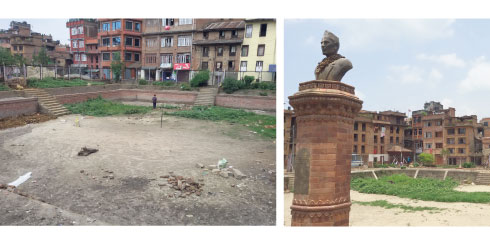KATHMANDU, June 27 :Barbed wire fences encircle two historic ponds in Madhayapur Thimi in Bhaktapur district and there is a narrow opening for the visitors. Beyond it, there are concrete pavements around the ponds for the visitors. And there are also thick water retaining walls around the ponds.
All these physical developments are meant for the conservation of two historic ponds known as "Dui Pokhari" in Madhayapur Thimi municipality. But ironically, the very infrastructure around the pond which date back to the Malla period has led to the drying up of the water bodies.
"Due to poor modern technical intervention, the historic ponds which served in our day-to-day living are virtually dead today," said Bal Krishna Shrestha, a local of the municipality who resides by the ponds. The ponds are believed to have been developed during the rule of Ganga Maharani in Bhaktapur during the Malla period. 
The two dried-up historical ponds in Madhayapur Thimi municipality in Bhaktapur.
Rabindra Shrestha, chief of the Physical Planning Implementation Sub-division in Madhyapur Thimi Municipality Office (MTMO), said the ponds dried up as the conservation efforts were carried out haphazardly. "The retaining walls in the ponds were developed after Madhayapur Thimi was promoted into a municipality in 1996. But while building the walls, workers mindlessly took out clay from the base of the ponds. Since then, the ponds started to dry up," said he.
According to experts, mud on the base of the traditional ponds in the valley served as a natural water retaining system to recharge water in the ponds even during the dry seasons. By removing the mud, bricks were laid on the base of the ponds in the name of the conservation of the ponds.
"In the name of the ponds conservation, the municipal authority turned the traditional water sources into swimming pools. Had the authority studied how the traditional ponds functioned, the ponds would not have dried up," said Prakash Amataya, an environmentalist.
Ever since the ponds have dried up, ground water level of the nearby wells in the vicinity of the ponds have remarkably lowered.
"There are around 15 wells in the vicinity. The wells almost dry up during the dry season ever since the pond dried up," said Bal Krishna, who is also coordinator of a consumer group who is working for the conservation of the pond.
The 56-year-old still remembers how he caught fish from the ponds and sold them in Ratnapark. "We used the money collected from sell for the conservation of other historical monuments in our locality. But gone are those days," he sighed.
Today, reviving the virtually dead historical ponds has been a major challenge for the MTMO. In the past three fiscal years alone, MTM office has spent over Rs. 4 million to retain water in the ponds.
"But it has been almost impossible to retain water. We are planning to set up rain water harvesting system to hold water in the ponds round the year," added the municipal officer.
However, Amataya says that the government should conserve the traditional ponds by using traditional skills.
"There are still people with traditional skills for the conservation of such ponds. I think the government should approach such people and employ them for the conservation. Otherwise, traditional ponds will be no different than modern swimming pools."
This year alone, the MTM office had allocated Rs. 1.5 million for the pond conservation. And conservation efforts are currently underway.
"But we are still unsure whether the ponds will retain water this time around. A large amount of money has already been spent on the conservation work, but to no avail," added Shrestha.

